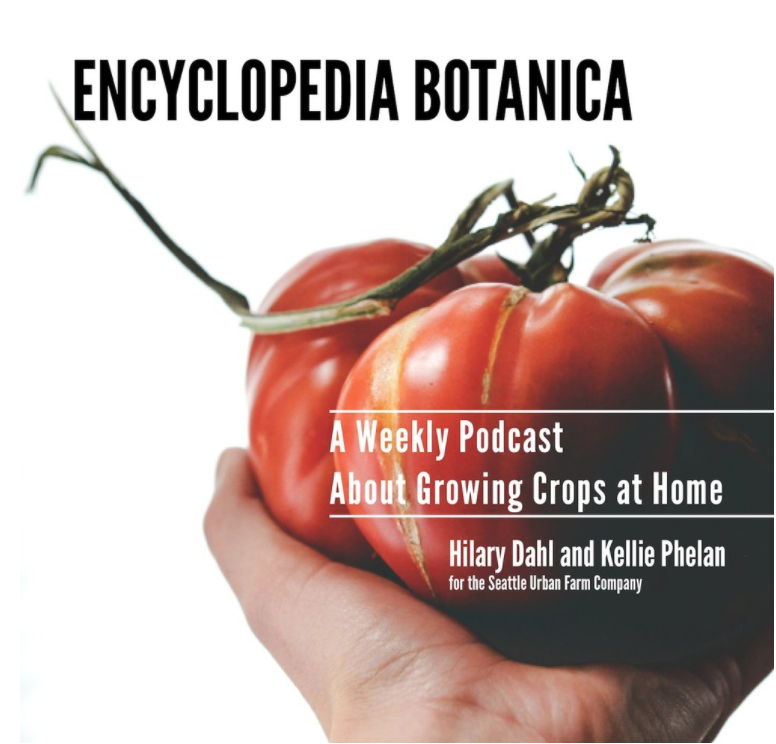Hello, I’m Hilary Dahl and this is Encyclopedia Botanica, a weekly podcast about edible gardening. This week we will be talking about fall vegetable crops and how to plan ahead to make sure you get them in the ground in time for a robust late season harvest.
Gardening is fraught with misnomers and confusing terminology. A classic example is the term “winter squash”. Experienced growers will know that cucurbits are categorized as winter squash if they are meant to be stored and eaten during the winter months. Examples include acorn squash, hubbard squash and pumpkins. However, beginners often assume that the term indicates that the crops should be planted in winter. You have no idea how many first time gardeners have asked us about planting Butternut squash in October.
Similarly, many beginning gardeners start their fall brassica and root crops too late in the season because they assume that these crops are planted in the fall, whereas these crops are actually meant to be harvested in the fall.
In order to have a successful fall and winter harvest, you need to start many of your crops in the peak of summer, meaning July and August in most regions. Some faster growing fall crops like lettuce and radishes can be planted into late September; But many desirable fall crops like Broccoli and Carrots need several months of prime growing conditions in order to mature before cold weather and low light levels set in.
Each crop has a relatively predictable lifespan, meaning that you can anticipate approximately how long it will take to reach harvestable size. The lifespan of the crop is usually defined by the phrase “days to maturity”. The exact days to maturity indicated for your crop on the seed package or plant tag will vary by environmental conditions, but should be fairly accurate. Some plants, once mature will live for several weeks or even months in the garden (examples of these crops are: broccoli, kale, beets and spinach), others need to be harvested quickly in order to capture their peak quality (examples of these crops are: lettuce, cilantro, and radish)
By planting fall crops in July and August, they have time to size up while the growing conditions are still good. Depending on your growing zone, these crops may be ready to start eating in September or October and, in milder climates like here in the Pacific Northwest, many of these crops can survive through the winter, providing much needed garden love in the gloomier months of the year. Think about winter gardening as a way to turn your vegetable plot into a giant refrigerator. If you plan properly, you can be harvesting from the garden all through the cold season and into the early spring.
A key to planning a successful fall garden is the proper management of spring and summer plantings. In most gardens, where space is limited, it is imperative that early season crops are harvested and removed from the garden in a timely fashion in order to make room for the new fall plantings. Examples of crops that may be finishing up in your garden mid-summer and should be cleared out to make room are Garlic, Onions, Potatoes and spring Brassicas like Cauliflower, Cabbage and Broccoli. You might also have some salad greens that are exhausted and ready to come out or even your spring beets and carrots. If you haven’t done a full year crop plan for the garden in anticipation of fall plantings, I would recommend doing an inventory of harvestable crops in the garden now and begin to figure out how much space you will have available over the next couple of weeks as things are ready to clear out and store.
Because fall weather is typically cooler and day lengths are shorter, fall and winter crops often keep their quality longer and bolt more slowly than summer crops. Fall crops have different levels of tolerance for cold, depending on species. Some, like spinach can handle consistent frosts and even snow. Others, like beets, should be harvested before hard frosts set in.
While all of this “fall gardening business” might sound too good to be true, you must keep in mind that only certain crops are cold tolerant enough to survive fall and winter weather. Therefore, your selection of plants will be more restricted than in the spring and summer.
With that being said, there are some great crops, probably some of your favorites, that you can plant for fall or winter harvest.
A list of crops for fall planting can be found on our blog, but here is a quick list of some of my favorite varieties:
Some examples crops that need to be planted earlier in summer (so right about now) for fall success are Beets, Broccoli, Cabbage, Carrots, Cauliflower, and Kale. Specific varieties I like are: Arcadia Broccoli, Marathon Broccoli, Melissa Savoy Cabbage, Nelson Carrots, Snow Crown Cauliflower, and Lacinato Kale.
Great fall choices that can be planted later in the summer and into early fall are Arugula, Lettuce, Mustard Greens, Radishes and Spinach. In fall, I particularly like growing Romaine head lettuce, Mizuna, Watermelon Radishes and Regiment Spinach.
To circle back to timing, it is important to remember that, in general, fall crops need a little extra time to mature because the amount of daylight they are receiving less and less daylight as the season progresses- so when in doubt plant your fall crops a little early.
Well, that’s it for this week, you can read a lot more about fall and winter gardening on our blog and in both of our books, Food Grown Right, In Your Backyard and High-Yield Vegetable Gardening. Get out there, find some space in the garden and get your fall crops growing!




